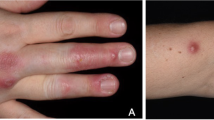Abstract
Purpose
Invasive Mycobacterium marinum disease (tenosynovitis and osteomyelitis) may be an increasingly common manifestation of M. marinum infection that presents unique diagnostic and therapeutic challenges. We conducted a retrospective case series and literature review of M. marinum infection to better understand the clinical spectrum of invasive versus cutaneous disease.
Methods
We reviewed electronic medical records for all M. marinum infections at Duke University Medical Center from January 1, 1996 to April 30, 2014. Published case series of M. marinum infection since 1990 reporting >5 cases were systematically ascertained and reviewed.
Results
Twenty-eight cases of M. marinum infection were identified from our institution. Twenty cases (87 %) involved aquatic exposure, and 26 (93 %) involved finger and/or hand lesions. Median time to diagnosis was 3.5 months. Nineteen (68 %) cases had invasive infection, and 9 (32 %) were cutaneous; invasive infection was more common with older age. Granulomatous inflammation and acid-fast bacilli were noted on pathologic examination in 11 (58 %) and 3 (16 %) cases, respectively. Primarily monotherapy was used in 2 (12 %) cases, dual therapy in 8 (47 %) cases, and three-drug therapy in 7 (41 %) cases; three-drug therapy was more common with invasive infection. Median duration of treatment was 5 months. Adjunctive surgery was performed for 18 (95 %) cases of invasive infection and 4 (44 %) of cutaneous infection. Twenty-one (75 %) cases improved, while 7 (25 %) were lost to follow-up.
Conclusions
Distinguishing between invasive and cutaneous M. marinum infection may have important consequences in terms of antibiotic choice and need for adjunctive surgery.

Similar content being viewed by others
References
Lewis FMT, Marsh BJ. Fordham von Reyn C. Fish tank exposure and cutaneous infections due to Mycobacterium marinum: tuberculin skin testing, treatment, and prevention. Clin Infect Dis. 2003;37:390–7.
Griffith DE, Aksamit T, Brown-Elliott BA, Cantazaro A, Daley C, Gordin F, et al. An official ATS/IDSA statement: diagnosis, treatment, and prevention of nontuberculous mycobacterial disease. Am J Respir Crit Care Med. 2007;175:367–416.
Stamm LM, Brown EJ. Mycobacterium marinum: the generalization and specialization of a pathogenic mycobacterium. Microbes Infect. 2004;6:1418–28.
Jernigan JA, Farr BM. Incubation period and sources of exposure for cutaneous Mycobacterium marinum infection: case report and review of literature. Clin Infect Dis. 2000;31:439–43.
Aubry A, Chosidow O, Caumes E, Robert J, Cambau E. Sixty-three cases of Mycobacterium marinum infection. Arch Intern Med. 2002;162:1746–52.
Harris DM, Keating MR. Mycobacterium marinum: current recommended pharmacologic therapy. J Hand Surg Am. 2009;34:1734–5.
The New York City Department of Health and Mental Hygiene. Health department warns patrons of seafood markets in Chinatowns about skin infection from handling live or raw fish or seafood. 2014. http://www.nyc.gov/html/doh/html/pr2014/pr006-14.shtml. Accessed 17 Oct 2014.
Feng Y, Xu H, Wang H, Zhang C, Zong W, Wu Q. Outbreak of a cutaneous Mycobacterium marinum infection in Jiangsu Haian. Chin Diagn Microbiol Infect Dis. 2011;71:267–72.
Horvath MM, Rusincovitch SA, Brinson S, Shang HC, Evans S, Ferranti JM. Modular design, application architecture, and usage of a self-service model for enterprise data delivery: the Duke Enterprise Data Unified Content Explorer (DEDUCE). J Biomed Inform. 2014;pii:S1532-0464(14)00153-1.
Centers for Medicare and Medicaid Service. ICD-9 Code Lookup. 2014. http://www.cms.gov/medicare-coverage-database/staticpages/icd-9-code-lookup.aspx. Accessed 16 Oct 2014.
Cheung JPY, Fung B, Ip WY, Chow SP. Mycobacterium marinum infection of the hand and wrist. J Orthop Surg. 2012;20:214–8.
Wu TS, Chiu CH, Yang CH, Leu HS, Huang CT, Chen YC, et al. Fish tank granuloma caused by Mycobacterium marinum. PLoS One. 2012;7:e41296.
Eberst E, Dereure O, Guillot B, Trento C, Terru D, van de Perre P, et al. Epidemiological, clinical, and therapeutic pattern of Mycobacterium marinum infection: a retrospective series of 35 cases from southern France. J Am Acad Dermatol. 2012;66:e15–6.
Chen HY, Chen CY, Huang CT, Ruan SY, Chou CH, Lai CC, et al. Skin and soft-tissue infection caused by non-tuberculous mycobacteria in Taiwan, 1997–2008. Epidemiol Infect. 2011;139:121–9.
Abbas O, Marrouch N, Kattar MM, Zeynoun S, Kibbi AG, Rached RA, et al. Cutaneous non-tuberculous mycobacterial infections: a clinical and histopathological study of 17 cases from Lebanon. J Eur Acad Dermatol Venereol. 2011;25:33–42.
Dodiuk-Gar R, Dyachenko P, Ziv M, Shani-Adir A, Oren Y, Mendelovici S, et al. Nontuberculous mycobacterial infectious of the skin: a retrospective study of 25 cases. J Am Ac Dermatol. 2007;57:413–20.
Ho MH, Ho CK, Chong LY. Atypical mycobacterial cutaneous infections in Hong Kong: 10-year retrospective study. Hong Kong Med J. 2006;12:21–6.
Hess CJ, Wolock BS, Murphy MS. Mycobacterium marinum infections of the upper extremity. Plast Reconstruct Surg. 2005;115:55e–9e.
Ang P, Rattana-Apiromyakij N, Goh CL. Retrospective study of Mycobacterium marinum skin infections. Int J Dermatol. 2000;39:343–7.
Edelstein H. Mycobacterium marinum skin infections. Arch Intern Med. 1994;154:1359–64.
Iredell J, Whitby M, Blacklock Z. Mycobacterium marinum infection: epidemiology and presentation in Queensland 1971–1990. Med J Aust. 1992;157:596–8.
Hsiao CH, Cheng A, Huang YT, Liao CH, Hsueh PR. Clinical and pathological characteristics of mycobacterial tenosynovitis and arthritis. Infection. 2013;41:457–64.
Conflict of interest
The authors have no potential conflicts of interest to report.
Author information
Authors and Affiliations
Corresponding author
Rights and permissions
About this article
Cite this article
Johnson, M.G., Stout, J.E. Twenty-eight cases of Mycobacterium marinum infection: retrospective case series and literature review. Infection 43, 655–662 (2015). https://doi.org/10.1007/s15010-015-0776-8
Received:
Accepted:
Published:
Issue Date:
DOI: https://doi.org/10.1007/s15010-015-0776-8




